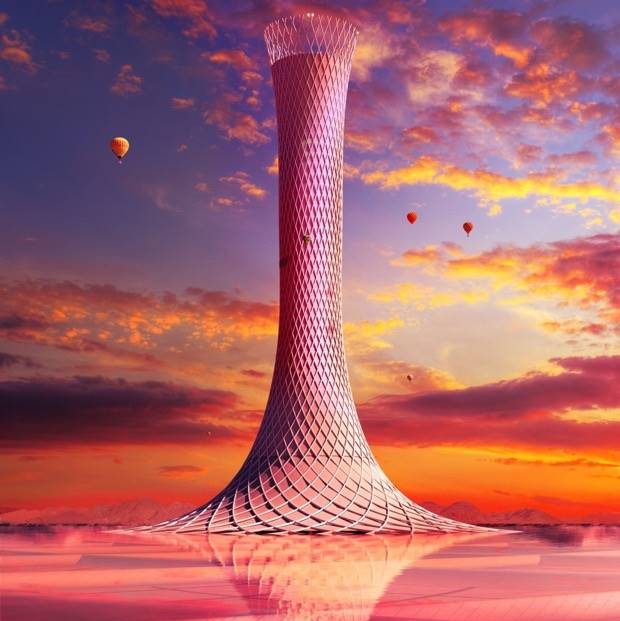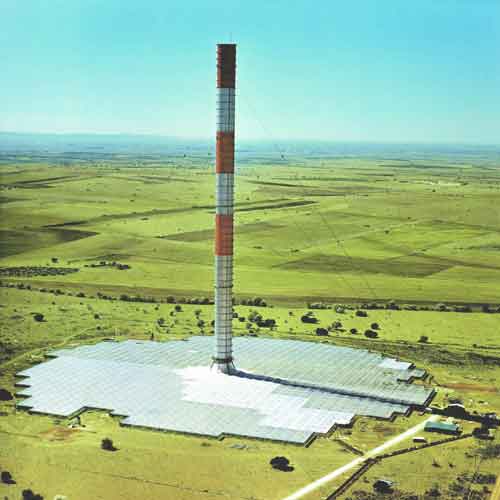Introduction
Power plants based on the “chimney” (or “updraft”) effect are renewable energy sources that could help mitigate climate change. One of the main challenges they face is the construction of the tower or chimney. These structures must not only be very tall (from 200 to 1000 m), but also affordable to ensure the project's viability. In this context, our node-based construction system could be key to making this type of power plant a reality in the near future. para asegurar la viabilidad del proyecto. En este contexto, nuestro sistema de construcción basado en nodos podría ser clave para hacer realidad este tipo de plantas de generación de energía eléctrica en el futuro cercano.
A bit of history
Power generation plants based on the “updraft” or “chimney effect” principle have been documented since 1903 (in an article by Isidoro Cabanyes in the Spanish magazine La energía eléctrica). A schematic of this type of power plant is shown in Figure 1, while Figure 2 presents a conceptual proposal by the company Enviro-Mission™. More information on such plants can be found at here.

Figure 1. Scheme of a solar tower that operates with convective air. Source: Wikipedia

Figure 2. Conceptual vision of a commercial-scale solar updraft tower. Source: EnviroMission
Spain is an ideal country to develop this technology, given that it has vast sunny, flat, and accessible (sparsely populated) land areas, as well as a long tradition of solar energy development. Evidence of this is that in 1982 an experimental power plant of about 50 kW was built in Manzanares (Ciudad Real, approximately 150 km south of Madrid) with a tower 195 m tall and 10 m in diameter, using German capital. This plant successfully collected data until 1989, when the tower failed due to a design flaw related to oxidation, highlighting the critical importance of robust tower design and longevity.

Figure 3. Solar chimney in Manzanares (Ciudad Real, Spain). Thisproof-of-concept operated successfully for several years during the 1980s. Photograph by SCHLAICH BERGERMANN SOLAR
Recently, international business initiatives have emerged. Notably, Lindstrand Tech (https://www.bbc.com/news/technology-25015030) and Enviro-Mission (https://www.enviromission.com.au), both at the conceptual level, face the challenge of constructing chimneys approximately 1000 m tall at a reasonable cost in order to optimally harness ideal atmospheric conditions.
The viability of this type of power plant—which produces 100 % clean and safe energy—lies in being able to construct the structural skeleton of the solar chimney at minimal economic, environmental, and visual cost.
The few existing precedents have been realized using cylindrical geometries that are far from optimal both functionally (with a variable nozzle-type cross-section, depending on expected flow in each section) and aesthetically.
Commercial-scale solar stack plant tower solutions (1 km in height) are usually based on enormous and expensive reinforced concrete constructions. In contrast, at Anisopter and UVa, we intend to overcome these limitations by constructing an optimized and lightweight steel structure that is affordable, recyclable, and visually appealing—thanks to new computer calculation methods, new manufacturing technologies, and modern on-site assembly techniques.
Interested companies
Main companies interested: EnviroMission (Australia), Enel Green Power Energy (Rome), Hyperion Solar Energy (United States), SunCentral (United States), Atlantis Solar (United States), SunPower Corporation (United States), BrightSource Energy (United States), Pivot Energy Inc. (United States), Hanwha Q CELLS GmbH (Germany), Jinko Solar (China), and others.
Schlaich Bergermann Partner (SBP) is a German company founded in 1980 by Jörg Schlaich and Rudolf Bergermann, pioneers in the design of lightweight and efficient structures and the firm responsible for building the Manzanares solar chimney in 1982 [ REF].
sbp sonne gmbh is a German company founded in 2009 as an offshoot of SBP and based in Stuttgart. It is dedicated to developing integrated solutions and systems for harnessing solar radiation. Its mission is to develop and implement innovative and cost-effective technologies oriented toward the future. It can conduct feasibility studies, solar efficiency and performance calculations, review technologies and concepts, and calculate the LCoE.
EnviroMission Limited is an Australian company founded in 2000 and based in Melbourne. It owns and promotes solar updraft tower technologies for generating renewable, clean, sustainable, and disruptive energy. It is a public, unlisted entity that operates to develop solar tower technology in global markets through joint ventures, partnerships, and licensing agreements. Additionally, it is the only developer and promoter of Solar Cyclone Tower technology in Australia, aiming to bring the solar stack tower concept to fruition. Solar Cyclone Tower en Australia cuyo objetivo es hacer realidad el concepto de torres de tiro solar.
https://www.greentechmedia.com/articles/read/enviromission-secures-30m-hybrid-debt-equity-facility
https://en.wikipedia.org/wiki/EnviroMission
Solar Updraft Energy UG is a German limited liability company founded in 2016 and based in Munich, dedicated to solar thermal energy. Its main objective is to establish industrial-scale solar stack power plants to generate sustainable electricity over extended periods. It provides solutions for all project phases during plant construction and operation, with specialized expertise in design implementation, industrialization, project management, construction monitoring, and plant operation, including service and maintenance concepts.
Lindstrand Technologies is an English company based in Shropshire, Shropshire dedicated to manufacturing inflatable structures. One of its objectives is to verify whether it is possible to fabricate the structure of a solar stack tower that is inflatable and made of fabric, making it earthquake-proof. More information can be found in the following National Geographic article:
Additional information
Market reports
https://www.transparencymarketresearch.com/solar-updraft-tower-market.html
https://www.linkedin.com/pulse/solar-updraft-tower-market-current-scenario-future-prospects-vetal/
https://www.htfmarketintelligence.com/report/global-solar-updraft-tower-market


 LA TROMPETA DE JERICÓ
LA TROMPETA DE JERICÓ 
